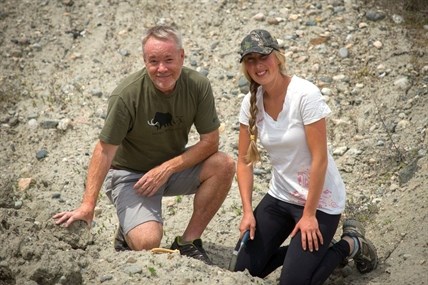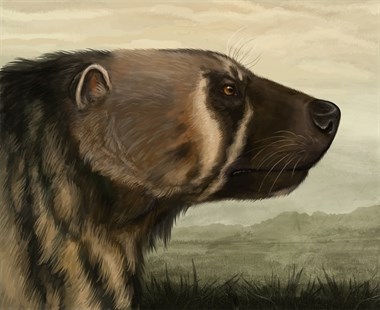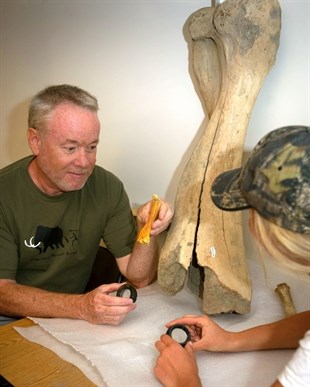
Rob Young, left, demonstrates to recent UBCO grad Lisa Hettrich how he came across the humerus while looking for rocks in a gravel pile in Alberta.
Image Credit: Contributed/UBCO
July 12, 2014 - 4:29 PM
KELOWNA - Like a good detective story, Rob Young’s mystery began with a bone found in a pile of stones and dirt.
Young, an environmental sciences professor at UBC’s Okanagan campus, didn’t find this particular bone at a crime scene, but in the Rocky Mountain foothills of Alberta. And it was no ordinary bone, but a rare find of a humerus from a Plesiogulo – a pre-historic, wolverine that lived about five million years ago.
Adults were about 100 pounds, or the size of a small bear.
The fact that this species of paleo wolverine didn’t last for long, in primordial terms, means the five-million-year-old humerus gives researchers who study the geological formation of landscapes a much better idea of how fast the prairie landscape was formed.
“It was an extraordinary find,” Young says of the discovery.
To find fossils from mammals in the former high, dry, land areas is extremely rare, because most of that landscape has been eroded away,” says Young. “This find is the first of its kind, and it proves to be a great indicator of time, and it has been found in a geologically significant location. This fossil represents a hat-trick of scientific significance.”
Young’s research focusses on the reconstruction of prehistoric events and environments using sedimentology, stratigraphy, and geomorphology. In particular, he has been studying the landscapes in south-western Alberta and has pieced together how the land became shaped the way it is.

An artist-rendering of the Plesiogulo wolverine, a creature estimated to be the size of a small bear that roamed the earth about five million years ago.
Image Credit: Contributed/UBCO
He wonders how long it took for the region to erode, by thousands of feet, to its current elevations. It’s a question that keeps taking the UBC researcher back to Alberta’s dry lands in the Hand Hills area of the ancestral Bow River.
Young discovered the bone 14 years ago, when he and Jim Burns, a paleontologist at the Royal Alberta Museum at the time, were working on a research series about ice-age prairie dogs in the Southern Alberta high hills. There were prairie-dog burrows in the ancient sand and gravel deposits, which also gave up a wealth of unrelated fossils.
Rhinoceros bones had been recovered earlier, and Young and Burns found three-toed and single-toed horse teeth and large camel bones while combing the area.
“We were fanned out across a slope, slowly going over the site methodically, and bingo!” says Young, of finding the paleo wolverine humerus.
To Young, the bone is a clue to a larger puzzle.
“My tools are knowledge of the physics and principles of sediment erosion, transportation, and deposition,” says Young. “Inferences about environments are enhanced by fossils found in sediments. Fossils are also useful because life changes with time, and so the fossil record reflects the timing of events, and tells us something about the rate of change.”

Rob Young, left, and recent grad Lisa Hettrich examine the humerus and compare it to one from a Woolly Mammoth.
Image Credit: Contributed/UBCO
The wolverine migrated from Eurasia, became widespread, and then went extinct in the Americas within that time. Like the modern wolverine, it was likely a solitary scavenger with a powerful bite and a temperament to give a good accounting of itself when faced with competition for a kill, says Young.
The Plesiogulo age, when this wolverine lived, was a condensed period that Young refers to as “a short 600,000 years.”
With an inland sea and deltas dominating the western interior of North America until about 50 million years ago, thousands of feet of sedimentary layers formed. Uplift of the Rockies caused terrain to shift eastward. Occasionally small isolated gravel deposits were left untouched, becoming hilltops as the river erosion continued. Young studies these gravel deposits to date the geographic formations.
“When you look at the landscape there are so many questions we have yet to answer,” he says. “Simple things like with all the land thrusting and fluvial mechanisms that took place, why are the prairies so flat and when did they get that way?”
Young recently discussed his find when he presented his research Post Paleocene Landscapes of the Western Interior and the Timing of Plains Formation at a conference in Victoria. He will make a similar presentation to the national Geological Society of America this fall.
And for the wolverine’s humerus? It has been added to the collections at the Royal Alberta Museum, and a cast has been made for Young’s classes at the Irving K. Barber School of Arts and Sciences.
News from © Contributed/UBCO, 2014